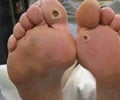In patients with diabetes, heart rhythm disorder (atrial fibrillation) can be detected during annual foot assessments.
Highlights:
- Diabetes is an independent risk factor for atrial fibrillation (heart rhythm disorder)
- Annual foot checks are advised for patients with diabetes
- This intervention has the potential to avoid strokes and preserve quality of life
Prevalence of the heart rhythm disorder is at least two-fold higher in patients with diabetes compared to those without. Although people with atrial fibrillation have a five times greater risk of stroke, anticoagulation medication is an effective preventive therapy. Increased blood sugars cause poor circulation, nerve damage and numbness, and could ultimately lead to foot amputation if problems go undetected.
Dr. Kanellos said: "The yearly check-up includes palpating the arteries in the feet to examine whether there is healthy blood flow. During this examination we noticed that some patients had an irregular rhythm and decided to investigate its usefulness for diagnosing atrial fibrillation."
Two podiatrists and six podologists were trained to spot rhythm abnormalities during pulse palpation of the foot arteries. They were also shown how to confirm their findings using a hand-held Doppler ultrasound device.
The 12-month observational study included 300 patients with diabetes attending their annual foot screening appointments. Patients with rhythm abnormalities during pulse palpation of their foot arteries underwent a Doppler ultrasound to verify the observations.
The average age of participants was 60 years. There were 180 men and 120 women. The researchers found that 51 patients (17%) had previously undiagnosed atrial fibrillation. The heart rhythm disorder was found in a similar proportion of men and women.
Source-Eurekalert
















